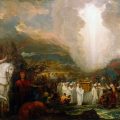Question
Gramps,
I was wondering today as I read a book that a non-Mormon friend gave to me to read. It raised a few questions inside of me. The biggest question on my mind is in regards to a man named Emanuel Swedenborg. He wrote a book called ‘A Treatise Concerning Heaven and Hell.’ In it, he discusses his doctrines of eternal progression, plurality of kingdoms, continuing revelation, eternal marriage and pre-existence. He also describes the manner in which he claims God to have appeared to him. The thing is: this was all written before Joseph Smith was ever born. All of these things are strikingly similar to what I am taught. If a friend approaches me with the argument that the prophet ‘borrowed these ideas’ from Swedenborg, how do I defend him? Thanks so much, Gramps! You’re the best!
Hiram
Answer
Dear Hiram,
Emanuel Swedenborg (1688 – 1772) was quite a man! He was a leading scientist of his time and his work resulted in a religion that exists to this day–the Swedenborgian Church or, as it is sometimes called, The Church of the New Jerusalem. Interesting enough, and in accordance with other great reformers of his time, such as John Wesley, he never intended to form a new religion or that a church be named after him. Nevertheless, such a society was formed in London 15 years after his death. This 1787 organization eventually spawned the present General Convention of Swedenborgian Churches. Emanuel Swedenborg could be counted among the great reformers of which President Thomas S. Monson spoke in his conference address at the April 1997 General Conference of the Mormon Church—
“In due time honest men with yearning hearts, at the peril of their very lives, attempted to establish points of reference, that they might find the true way. The day of the Reformation was dawning, but the path ahead was difficult. Persecutions would be severe, personal sacrifice overwhelming, and the cost beyond calculation. The reformers were pioneers, blazing wilderness trails in a desperate search for those lost points of reference which, they felt, when found would lead mankind back to the truth Jesus taught.
“John Wycliffe, Martin Luther, Jan Hus, Zwingli, Knox, Calvin, and Tyndale all pioneered the period of the Reformation. Significant was the declaration of Tyndale to his critics: I will cause a boy that driveth the plough shall know more of the scripture than thou doest. Such were the teachings and lives of the great reformers. Their deeds were heroic, their contributions many, their sacrifices great but they did not restore the gospel of Jesus Christ.” (President Thomas S. Monson, “They Showed the Way,” Ensign, May 1997, p.50)
Some of the leading tenants of the church that was developed from the philosophy of Swedenborg are the following:
1. The Second Coming has already taken place – and in fact still is taking place. The Second Coming is not an actual physical appearance of the Lord, but rather his return in spirit and truth that is being effected as a present reality.
2. We live in a world of spirit as well as in the material world, although we are usually unconscious of that dimension of our existence. With death we become conscious in the spiritual world, where our personal identity is retained and we are revealed as the person we inwardly are.
3. Jesus Christ was a manifestation of God, the Divine made flesh to enable humanity to be aware of a unique relationship with God. Prior to his Coming, God had been incomprehensible to humans beyond the capacity of our perception and understanding. Through the birth of Christ, humanity was given an overt expression of God’s reality in human terms. Christ is not seen as a separate entity, but as reflective of the multiple consciousness that is the oneness of God. There are not three divine beings comprising the trinity, but one Divine Nature in which the three aspects of God are present.
I think that our challenge in life is not to try to find the faults of other churches, in order to establish that they are not true, but to test the validity of our own church and attempt to gain a witness from the Holy Spirit that ours is the one true and living Church of Jesus Christ, the very organization of his kingdom on the earth that embodies within its organization and teachings the way of life and salvation. If ours is indeed that Church, and we test its precepts by living in accordance with them, the Holy Spirit will give us a firm and abiding witness of the truths that we are practicing. If ours is not that Church, no such powerful and divine witness will be manifest, and we may then know that it is an organization of man and not of God.
Gramps







